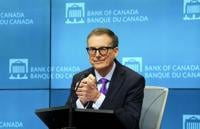TORONTO - With interest rates likely at or near their peak in Canada, experts say consumers shouldn’t expect rates to return to pre-pandemic levels.
The central bank is more likely to bring its overnight rate to between two and three per cent, though not anytime soon, said David Macdonald, senior economist with the ´şÉ«Ö±˛Ą Centre for Policy Alternatives.
“That’s a ways off. That’s not next year,” he said, adding that consumers may not have fully grasped this yet.
The Bank of Canada on Wednesday held its overnight rate at five per cent, after a breakneck tightening cycle from near-zero in March 2022. The overnight rate affects interest rates offered by financial institutions.
The Bank of Canada’s overnight rate was 1.75 per cent throughout 2019, before the central bank dropped it to a quarter of a point to support the economy during the onset of the COVID-19 pandemic.
The central bank is widely expected to hold rates high in the near term as it seeks to quell inflation. But even once rates begin to fall, economists said ultralow rates aren't in the cards.
The ´şÉ«Ö±˛Ą economy, and consumers along with it, is going through an accelerated paradigm shift, said TD chief economist Beata Caranci -- less a gradual shift than a cold glass of water to the face.
Caranci thinks ´şÉ«Ö±˛Ąs are aware that interest rates aren’t going back to pre-pandemic levels, but she also thinks they’re too optimistic about when, and how fast,rates will go down.
Borrowers have been increasingly opting for shorter terms on their mortgages, hoping rates will be lower in a year or two, she said.
Thatmay well happen, but it’s not a guarantee, she said.
“If you look at our forecast, if you look at the consensus on the street ... Most people have some cuts coming in by the second half of next year. But that's presumed that the economy is weaker than it is today,” said Caranci.
“One of the points I've been stressing with our clients is, the speed at which rates went up will not be the speed at which they go down.”
In a report Wednesday, CIBC Capital Markets chief economist Avery Shenfeld said the central bank will likely be able to ease its overnight rate to 3.5 per cent by the end of next year.
A term that’s often used to describe where the overnight rate may go -- or where it should go -- is the neutral rate. That’s essentially the “Goldilocks” of the central bank’s rate, explained Caranci: “It's an interest rate that allows the economy to grow neither too hot or too cold.”
In an Oct. 5 report, Caranci and senior economist James Orlando wrote that they believe the neutral rate in the U.S. is on the rise due to factors like climate change investment, changing supply chains and higher government deficits.
“A higher neutral rate means that the current policy rate may not be as restrictive as the (U.S. Federal Reserve) thinks,” they wrote.
A similar trend is at play in Canada, according to Caranci and Orlando, but ´şÉ«Ö±˛Ą consumers' high debt levels mean a lower neutral rate north of the border.
Prior to the pandemic, rates in Canada and globally had been historically low for years, said Macdonald -- because inflation had been low for decades.
Rates were as low as half a percentage point during the past decade, including for a two-year stretch between July 2015 and July 2017. Over the past 10 years, the average overnight rate was 1.27 per cent.
There are downsides to having very low rates, said Macdonald, including the fact that when recession hits, the central bank has very little room to stimulate the economy by lowering rates further.
Over the years, low rates also contributed to a housing boom, he said. The Bank of Canada’s mandate is to keep inflation in check, Macdonald said, but home prices aren’t included in the Consumer Price Index.
The seasonally adjusted average price of a home in September was $669,689, according to the ´şÉ«Ö±˛Ą Real Estate Association, a 70 per cent increase from $392,647 a decade earlier and a 216 per cent increase from $211,893 in September 2003.
This “explosion” in home prices drove substantial wealth inequality over time, said Macdonald, as anyone lucky enough to have their foot in the door at the right time saw their wealth grow, while others were left behind.
He agrees that ´şÉ«Ö±˛Ąs are now in a “difficult period of adjustment,” where household budgets are being eaten up by mortgage costs, rent is on the rise and house prices are expected to moderate. That adjustment has really just begun, he said.
“We’ve still got a long way to go at these much higher interest rates and much higher inflation.”
-- With files from Nojoud Al Mallees
This report by ´şÉ«Ö±˛Ąwas first published Oct. 27, 2023.








































